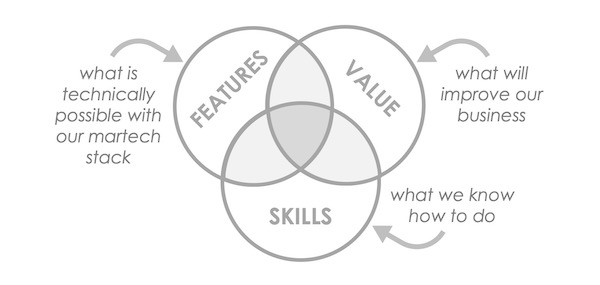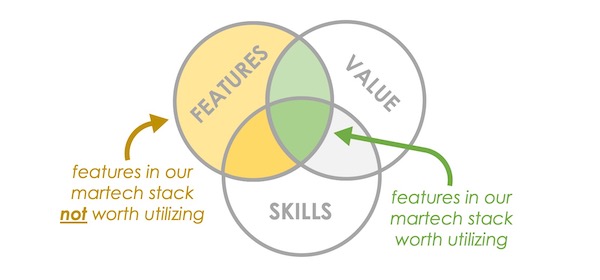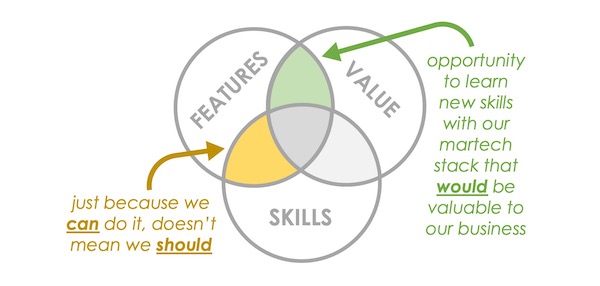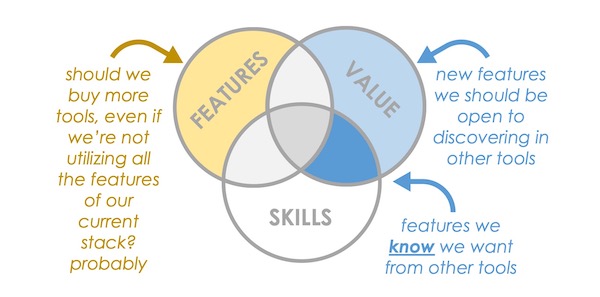Back in the early days of martech, there was an apocryphal statistic that most marketers only used about 15% of the capabilities of their marketing automation systems. (I heard this stat thrown about for years, but googling suggests that SiriusDecisions published it officially in 2013.) Marketers would buy these sophisticated tools, but then just keep pumping out the same old batch-and-blast emails to their entire list.
A research study in 2015 showed that, even years later, the majority of marketers felt they didn’t fully utilize the tools they had in their expanding martech stack.
I used to think this was unequivocally a bad thing, to have “utilization” of martech products be so low. The implications, slightly oversimplified, were one of two things:
- Marketers didn’t know how to use the martech they purchased.
- Marketers purchased martech they didn’t need.
The solutions seemed obvious:
- Marketers: learn how to use your tools. And martech vendors: make your tools easier to use. (Insert “DAM tools” joke here.)
- Don’t buy more tools until you fully use the ones you have first. (As mom said, “Finish what’s on your plate before you help yourself to more!”)
Simple, right? Martech utilization will soar and everyone can grab a pint at the pub.
Fast forward to the present day. Now, many companies have developed, hired, or outsourced martech skills. The principle of rationalizing your martech stack — pruning out tools that don’t contribute net value to your business — has become a best practice. Yet still the question of martech stack utilization comes up.
But it struck me recently that utilization can be a misleading metric.
As shown in the Venn diagram at the top of this post, let’s consider three overlapping aspects of martech:
- FEATURES — what is technically possible with our martech stack
- SKILLS — what we know how to do
- VALUE — what will improve our business
In a perfect world, these circles would overlap entirely. In practice, they don’t.
Just consider the explosion of features in martech products. They’ve become incredibly sophisticated. Which means most martech professionals are constantly having to upgrade their skills to learn how to use them. But while every feature (ideally) is likely valuable to some businesses, not all of them are valuable to all businesses.
I can almost guarantee you that there’s only a subset of features in your current martech stack that, if utilized, would deliver net positive value to your business today. Maybe that subset is large, maybe it’s small. The exact subset worth utilizing will undoubtedly change over time, as your business, customers, and stack evolve.
But utilization by itself doesn’t matter much. Value is what really matters.
It would be kind of like measuring whether your subscription to Spotify is worth it based on the percentage of their 35 million songs that you listen to. All that matters is if they give you the songs that you enjoy listening to — even if it’s but a tiny fraction of their massive overall catalog.
The only two reasons to care about utilization:
- Are there opportunities to learn new skills with unused features of our martech stack that would be valuable to our business? I’ll bet the answer is almost certainly, “Yes.”
- Are there products in our martech stack that we’re not getting value from that we should jettison? Or perhaps downgrade to a less expensive tier for the subset of functionality that we are productively harnessing?
Unused features that don’t correspond to one of those reasons are irrelevant.
And just because we have the skills to use certain features in our martech stack, doesn’t mean we should use them, unless we know we’re getting value from them. Everything we do costs something in time, effort, resources, complexity, and/or impact on customers. So if it’s not adding value, it’s at the very least an opportunity cost on other value creation activities we could be investing in.
One last point about this utilization view of martech stacks: this helps justify why acquiring new martech products can be a good thing — even if we aren’t fully utilizing the features of the products in our current martech stack.
If a new tool will let us deliver net positive value to our business — and it’s something that the tools in our existing martech stack, despite their ever-expanding plethora of features, aren’t able to provide — then, by all means, add the new tool.
Thinking about utilization is helpful as a path towards advancing our skills and bringing new value to our business. But utilization for its own sake is a fool’s errand.







Great article. Many times it’s overzealous entrepreneurs whose vision outshines necessity… Listen to the client…
Totally on point as usual, Scott. This is as much of an issue for agencies, specificallly HubSpot partners, who are expected to become familiar with an entire platform of 200+ integrations for a client’s martech stack. Agencies have a big job ahead of them deciding where they are going to invest their time and skills development in the world of integrated cloud platforms and apps..
That is so true, John, and is the real challenge for both sides of the table!
Great article. Thank you so much. It will be useful in next days.